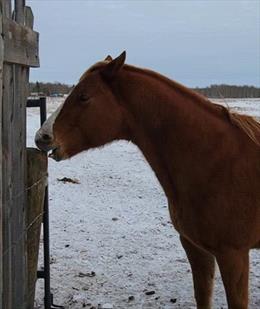Horse cribbing on wood.jpg

Photo Courtesy of Anneliese Heinrich MSc, DVM
Stereotypic behaviors are repetitive, relatively unvaried behaviors that have no obvious purpose and interfere with the functioning of the horse. They are relatively common in horses compared to other domestic species and can affect the welfare, health, and value of your horse.
Commonly referred to as stall or stable vices, stereotypic behaviors can be divided into two categories: oral and movement behavior. Oral stereotypies include cribbing, windsucking, wood chewing, licking, and tongue play. Movement stereotypies include stall walking, weaving, circling, pacing, head bobbing, and pawing.
Stereotypies have been linked to a lack of turnout, lack of social contact, frustration, lack of foraging opportunities and stimulating environments, high concentrate diets, what kind of work the horse is trained for, or weaning too early. There is evidence that stereotypic behavior is inherited. These behaviors often begin when the horse is young.
The reasons why your horse is showing stereotypic behavior are complicated. Behaviors may start as a coping mechanism under stressful conditions. When they occur only during stress (which for a stabled horse could be 24 hours/day) they are termed stereotypies. When the stress is gone but the horse continues the behavior, (i.e., a horse that begins walking circles in its stall but continues to do so in a large pasture) it can be called a compulsive disorder. Studies were done to see if the behavior is an obsession by seeing how hard a horse will work to perform the behavior.
There seems to be some genetic reasons for stereotypic behavior. While having a sire or dam with a stereotypy does not mean your horse will develop the behavior, stereotypies are more common in related horses. Certain breeds, such as Thoroughbreds, Warmbloods, and Arabians, may be more likely to develop stereotypic behavior; however, this may be related to housing and diet as well.
Stereotypic behavior is not considered transmissible. This means that if your horse watches another horse perform a stereotypic behavior, your horse is extremely unlikely to copy that behavior and develop the stereotypy. However, if the environment and management are poor, horses may be more likely to display these behaviors in general. Furthermore, the work your horse is trained for may also contribute to stereotypic behaviors. These are the reasons why some facilities appear to have a higher number of horses displaying these abnormal behaviors than others.
If you suspect stereotypical behavior, your horse should be examined by your veterinarian. Some repetitive behaviors may be caused by a nervous disorder or other medical condition. Your horse may have separation anxiety. Certain stereotypies can put a horse’s health at risk. For instance, cribbing can cause abnormal wear of teeth and colic. Stomach ulcers are also common in cribbers, although whether this is cause or effect is uncertain. Stereotypies involving movement may cause orthopedic or repetitive strain injuries.
Treatment of abnormal repetitive behaviors in horses centers around reducing the triggers of the behavior, such as improving the environment through suitable enrichment, reducing the amount of concentrate feed, and increasing roughage and daily turnout with compatible horses. Anti-anxiety medication may help horses with compulsive disorders.
Punishment of these behaviors is not a good idea because it does not decrease the behavior in the long run and may add stress, contributing to the behavior. Devises like crib collars may stop the behavior while your horse is wearing it, reducing some health risks. However, devices do not address why your horse is displaying the behavior, foraging and stopping the horse from doing it can cause stress.
Regardless of the cause of the behavior, repetitive behaviors in horses are difficult, if not impossible, to cure. Prevention is important and includes things like the natural weaning of foals, access to pasture (both for grazing and exercise), and social companionship. Breeding a horse that displays abnormal repetitive behavior is not recommended.